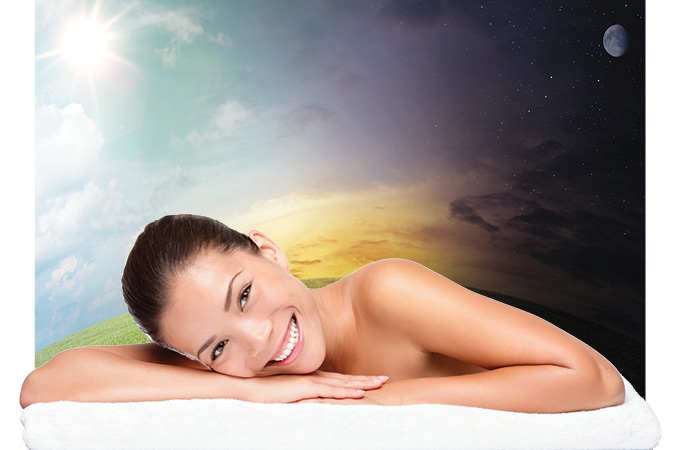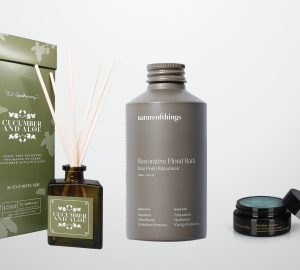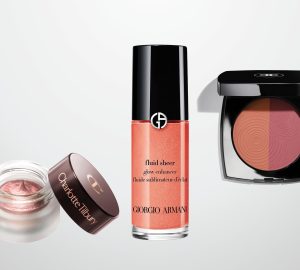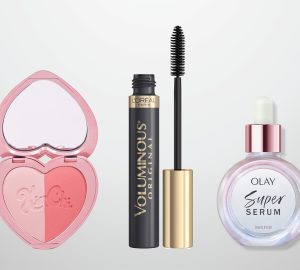We think a lot about what goes on our skin, but it may be equally important to consider when we apply certain products. T&S talked with Dr. Jennifer Fehlman, a board-certified SLUCare dermatologist, about how best to maximize the effectiveness of your morning and night skin care routines.
morning
According to Fehlman, the production of sebum, an oily secretion of the sebaceous glands, is highest in the morning and tapers off as the day continues. It helps protect against environmental factors, which are a major concern when designing your skin regimen. “During the day, we are exposed to a variety of stressors like blue light, pollution and UV rays that can damage skin cells,” she says. “For your morning routine, use products that combat exposure and eliminate some of the damage from the environment and sun.”
- Suncreen: The most important item in your morning skin care routine should be sunscreen. Fehlman says to apply it to any sun-exposed areas, not just the face, and to reapply throughout the day since it loses effectiveness after two hours. “Look for products that contain 5% zinc oxide,” she notes. “They block UV rays without getting absorbed into the skin. Plus, they tend to be gentler and don’t cause the irritation that comes with chemical sunscreens.”
- Antioxidants: “These are great to use in the morning because they create another layer of protection for your skin,” Fehlman says. “There are over-the-counter options and medical-grade products, sometimes referred to as cosmeceuticals. Talk with your dermatologist to determine what is best for you.” Antioxidants to look out for in skin care include vitamins C and E, ferulic acid and phloretin, a plant-based compound derived from the leaves of apple trees and the Manchurian apricot.
- Cooling: Redness and puffiness, especially around the eyes, can be a concern in the morning thanks to sleeping positions and patterns. “Using an eye cream at night and in the morning can help with puffiness and discoloration,” Fehlman says. “Talk with your dermatologist about what ingredients are best for your concerns. For your day cream, look for one with an SPF.” She adds that there are other options to help with cooling your face in the morning, such as eye masks and patches and jade rollers, which can help reduce swelling.
night
While you’re settling in after a long day, your skin is using the time to recover from all it was exposed to. “Production of new skin cells is higher at night, so you’re regenerating and healing the damage done,” Fehlman explains. “The skin is a little more receptive during this time, so products can be absorbed more easily. Look for topical skin care that is going to help with recovery.”
- Cleanser: “It’s important to start your nighttime routine with a gentle cleanser,” Fehlman says. “It will get rid of the dirt and impurities that accumulated over the course of the day.”
- Retinol: Retinol can have many benefits, including stimulating collagen and elastin production, which helps keep the skin looking supple and youthful. “Along with over-the-counter creams and serums, there also are prescription-strength retinoids,” Fehlman notes. “They aren’t for everyone. Some find them drying and irritating to the skin. It’s important to consult your dermatologist about what is best for you.” She suggests applying it very sparingly over clean, dry skin and leaving it to work overnight. Retinol and retinoids are less effective when used during the day because they can be inactivated by sunlight.
- Moisturizer: Moisturizer is important, especially if you use retinol since it can cause dryness and irritate your skin. “There are lots of tricks you can use to combat this,” Fehlman notes. “You can mix the two, so the retinol goes on more gently.” Another method is what is known as the “sandwich technique.” It requires applying a layer of moisturizer before and after the retinol or retinoid. When it comes to selecting a product, she recommends a general one with ingredients such as hyaluronic acid. “You may also see melatonin listed,” she adds. “There is not enough data yet, but it has been shown to have some wound healing and anti-aging properties in research.”








